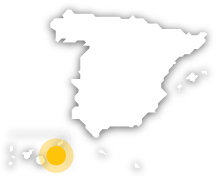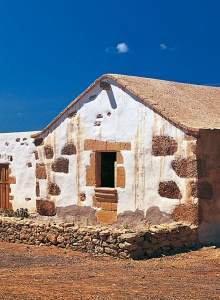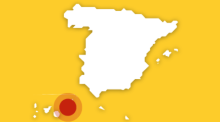Washed by the crystal-clear blue waters of the Atlantic, Puerto del Rosario is a lively commercial city full of attractions for tourists.
Sheltering behind the major port, the capital of Fuerteventura grew as a neat collection of houses of whitewashed streets turned towards a picturesque promenade. And alongside it, villages full of local colour and a beautiful coastline equipped with modern facilities and ideal for windsurfing.
Puerto del Rosario emerged at the end of the 18th century as a small cattle-raising centre on the current bay. The city, known then as Puerto de Cabras, was transformed in the middle of the 18th century into a prosperous commercial port, a fact which favoured it being declared capital of Fuerteventura in 1860, a status which until then was held by Betancuria.A city which is excellently connected by sea and air, Puerto del Rosario currently provides the chief port of access to the island, as well offering a good many tourist attractions, such as mild temperatures year-round and the beautiful beaches which cover its coastline. Beaches such as Puerto Lajas, Jarugo and Playa Blanca, this last one equipped with modern infrastructure which includes hotels, restaurants, shops and sports facilities. Any of these places has optimum conditions for surfing, windsurfing or sailing, not forgetting underwater sports such as scuba diving or spear fishing. Culture and HeritageStrolling through the historic quarter of Puerto del Rosario, the visitor will find a bright collection of whitewashed streets which house outstanding examples of architecture, such as the church of Nuestra Señora del Rosario, or the House- Museum of Miguel de Unamuno, located in a 19th century house. Photographs, furniture from the 20th century and other effects from the age make for an interesting tour of these premises, at which the Spanish writer lodged.Something else to attract tourists is located on the Promenade, converted into a genuine open-air gallery thanks to the sculptures of snails by the Canary Islands sculptor Juan Bordes.Surrounding areaLeaving the capital behind, Fuerteventura has many surprises in store for us. The dryness of its earth has given rise to the formation of ravines, while along the coast stretch heavenly beaches of fine sand and incredible dunes beside a sea of turquoise water. The sea is precisely one of the greatest attractions the island offers, not only because of the fascinating biological diversity hidden in the sea depths, but also because it is one of the best places in the world to do sail sports and above all windsurfing, a sport which each year attracts thousand of fans and professionals to the place.The island of Fuerteventura has several tourist centres. At the northern end we can visit Corralejo, a town which has an extensive beach of dunes. In the centre, only a few kilometres from the capital, is Caleta de Fustes. Further south, on the Jandía peninsula, is the chief tourist infrastructure on the island, with centres such as Costa Calma, located next to the beach of Sotavento, and Morro Jable. Those who wish to can take up windsurfing and other water sports such as surfing or scuba diving in any of the schools which exist in these places.The sparse population of the island has allowed the conservation of almost unspoilt ecosystems such as the Corralejo Nature Reserve, which occupies the northeastern strip of the island and is outstanding because of its imposing coastal dunes. Opposite is the Islote de Lobos Nature Reserve, with a valuable habitat in which native species of flowers grow. Lastly, in the south is the Jandía Nature Reserve, an area which is home to abundant examples of the islands' fauna and flora. GastronomyThe gastronomy of the islands is based both on produce of the land and on excellent fresh fish provided by its coastline. Species such as “vieja” (a local fish), horse mackerel or sama (similar to sea bream) are usually served fried or roast, although salted fish is also traditional. Outstanding in the meat department is roast baifo (kid) and roasted or marinated pork. Not forgetting recipes for other traditional Canary Islands specialities, such as Canary Islands stew and papas arrugadas (potatoes boiled in their jackets) with mojos (typical sauces). Fuerteventura cheese, made from goat's milk, enjoys much acclaim and has its own Designation of Origin standard.The only wines in the province are produced in neighbouring Lanzarote, outstanding among whose Designation of Origin standard is the magnificent produce of the Malvasía variety, with aromatic whites and delicious sweet wines.





